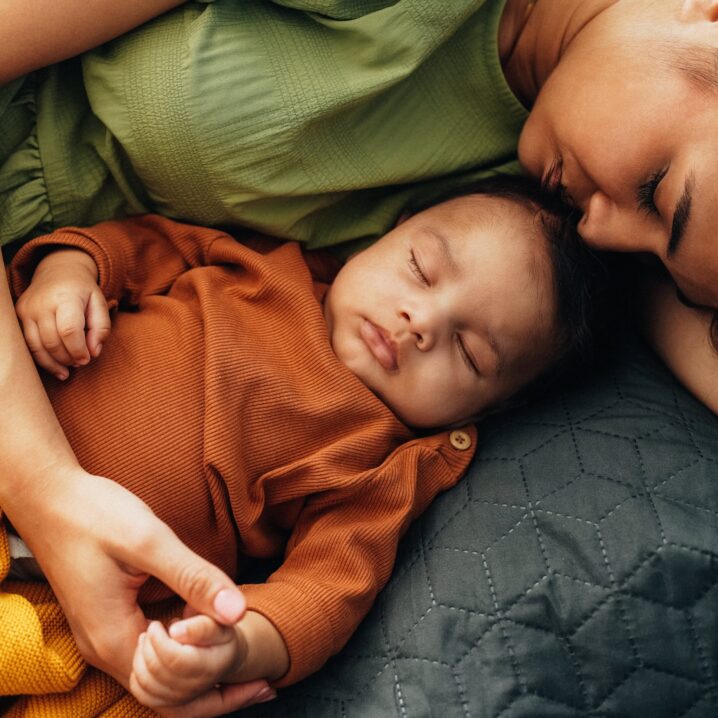
- POPSUGAR Australia
- Family
- Attachment Parenting Can Form Close Bonds, but Experts Say It’s Not Perfect
Attachment Parenting Can Form Close Bonds, but Experts Say It’s Not Perfect

Most parents form tight bonds with their children from the moment they’re born, but some styles of parenting foster that closeness more than others. Attachment parenting, for example, encourages parents to be on the same wavelength as their kids, even anticipating their needs before they happen.
Like all parenting styles, attachment parenting isn’t perfect, as one might imagine. The approach has gotten its fair share of criticism for inadvertently creating overly dependent children and putting outsized demands on parents, but plenty of people, including some celebrities, swear by it. Kourtney Kardashian, for example, spoke about planning to adopt an attachment style of parenting with Rocky, her son with Travis Barker. “That’s what I did for my last two kids, we didn’t leave the house for the first 40 days,” she told Vogue in 2023. “After, you’re super-connected and I love that.”
With all the chatter surrounding attachment parenting, it can be tough to know what this child-rearing style is really about. Here’s the deal, according to parenting experts.
What Is Attachment Parenting?
Attachment parenting stems from attachment theory, which claims that people are born with the innate desire and need to be closely bonded to a caregiver, like a parent. Developed in 1958 by British psychologist John Bowlby, attachment theory says that attachment systems help protect vulnerable people, i.e. children, from potential threats and harm, and helps them regulate negative emotions after threatening or harmful events, per a 1992 article in the journal, Developmental Psychology.
“The basic premise of this parenting style is promoting physical connection, physical understanding, and emotional reciprocity between the parent and the baby,” says Mayra Mendez, PhD, LMFT, a licensed psychotherapist at Providence Saint John’s Child and Family Development Center in Santa Monica, CA. “The idea is that we are one.”
This parenting style ultimately focuses on building a strong connection between parents and kids, says Robert Keder, MD, a pediatrician who specializes in developmental behavior at Connecticut Children’s Medical Center.
What Does Attachment Parenting Look Like?
With attachment parenting, the parent and baby do everything together. Mendez says, “You understand each other, and mom understands what baby’s cry means.” When babies cry in an attachment parenting style, the parent responds immediately. “Mom understands baby’s cues and baby understands that mom will respond and understands,” she adds.
Attachment parenting promotes physical closeness, too, like baby wearing and co-sleeping, Keder says. It can also feature extended breastfeeding, which is usually considered breastfeeding after 12 months. When kids get older, attachment parenting can mean having constant communication, as well as parents and children regularly doing things together.
“The most important thing in attachment parenting is the child having a strong, nurturing adult that they have a relationship with,” Keder says. “Kids understand that they can make mistakes in the world, but can come back to healthy adults who are there to help.”
The Benefits and Drawbacks of Attachment Parenting
The main perk of attachment parenting is that it helps the baby’s social and emotional development, Mendez says. “You teach the child social-emotional reciprocity,” she says. “It promotes the growth of cognitive ability and language, as well as good learning and responsiveness.”
Ultimately, that might lead to good stress management. “A child that is able to manage stress and is able to manage emotions in times of stress will have better outcomes in development and progress as they move on to school and relationships,” Mendez says.
The challenge with attachment parenting is “how to keep the attachment, but cut the cord of support and let children develop opportunities to practice and strengthen those tools they learned,” Keder explains.
Attachment parenting may also lead to over-protectiveness and over-attachment. “You run the risk of isolating the child from the social world and others,” Mendez says. “You run the risk of dependency because the child isn’t given enough independence.”
The American Academy of Pediatrics recommends that babies sleep in their own crib, but attachment parenting makes a case for bed-sharing, where the baby shares a bed with the mother. (Instead, another form of co-sleeping, where parents have a crib or bassinet in their room, is encouraged by the AAP until the baby is 6 to 12 months old.)
“Bed-sharing isn’t safe and attachment theorists promote it,” Mendez says. Bed-sharing is discouraged by the AAP due to the risk of suffocation, strangulation, and SIDS. Sharing a bed with a baby or toddler can also be a “burden” to parents if they need to get up early to go to work, Mendez adds.
Breastfeeding is heavily promoted in attachment parenting, but not all parents can provide this, Mendez points out. “There can be a lot of guilt if mom can’t breastfeed, since attachment theory promotes only breastfeeding,” she says.
Overall, Keder says that having children become overly attached to their parents is the main concern with attachment parenting since that doesn’t promote the independence they’ll need as adults. “It’s also not good to be over-focused on kids’ needs without thinking about what they need to prepare for the next thing,” he says. On the whole, however, Keder stresses that there “are no major cons to being attached to your child.”
Related: Parenting Without Diapers: Elimination Communication Explained
Korin Miller is a writer specializing in general wellness, health, and lifestyle trends. Her work has appeared in Women’s Health, Self, Health, Forbes, and more.

